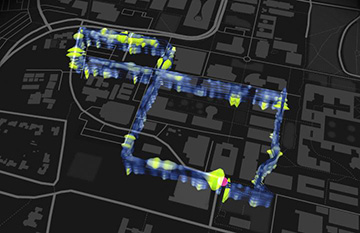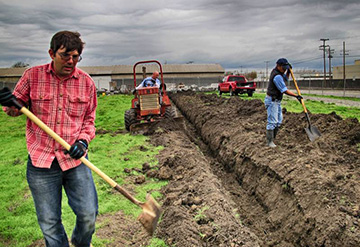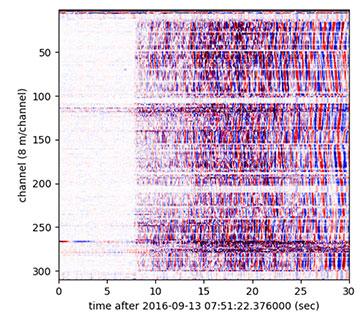
Researchers at Stanford University, Calif., USA, installed a 2.5-km run of optical fiber in existing conduit to test whether installed fiber might be used for earthquake monitoring. [Image: Stamen Design and the Victoria and Albert Museum]
Buried underground and on the seafloor, alongside the fiber optic cables that empower global communications, are kilometer on kilometer of “dark fiber”—additional cable installed by telecom companies that currently sits idle. Now, geophysicists in California are investigating a potential use for that dark fiber: detecting earthquakes.
Leveraging a technique recently developed for oil and gas field applications, a research team including scientists from the Lawrence Berkeley National Laboratory (LBNL) and Stanford University, USA, has established that a length of optical fiber can act as an array of thousands of tiny seismic monitors, with a horizontal resolution on the meter scale (Geophys. Res. Lett., doi: 10.1002/2017GL075722). That raises the prospect, the team believes, of vastly improving the coverage of earthquake monitoring in areas where seismologists have generally lacked access. It could also open up new ways to image the near surface for analyzing—and perhaps mitigating—earthquake hazards in urban areas.
Strain from backscattered light
The technique used by the LBNL-Stanford team, distributed acoustic sensing (DAS), begins with a specialized piece of hardware, an “interrogator,” that sends laser pulses down a length of optical fiber. A tiny amount of the pulse energy is Rayleigh-backscattered by small imperfections at various points along the glass fiber core’s length, and the interrogator reads the amplitude and phase of that returned light.
A change in the length of the fiber attributable to a passing disturbance—such as an earthquake wave—leads to a phase offset in the backscattered light; this is read interferometrically by the interrogator unit and mapped to the strain at a given point. What’s more, because the timing of the returned photons from the backscattered signal is proportional to the distance traveled along the fiber, the interrogator can retrieve backscattered information from a single pulse at various points along the entire fiber length.
As a result, the fiber hooked to the interrogator becomes an array of tiny 1-D strain sensors, with a spatial separation as small as a meter between them. And, by firing repeated pulses, the setup can provide information not just about the strain, but about the strain rate—a key parameter in backing out a seismic waveform from the data.
From the oilfield to earthquakes
DAS has been around since 2010, and has increasingly found use in projects related to oil and gas exploration, rail and road monitoring, and border and perimeter security. But it is only recently—according to coauthor Stephen Cole of OptaSense, the company that provided the interrogators for the Stanford part of the project—that steady improvements in the lasers and recording technology have brought such systems close to the sensitivity and quality of standard geophones (the recording units conventionally used in reflection seismology). “It’s just in the last few years, really, that we’ve gotten to the level of quality that we could do this kind of work,” says Cole.

Jonathan Ajo-Franklin (left) working on the trenched fiber optic test array at the Richmond Field Station. [Image: Jonathan Ajo-Franklin]
To test out the potential for DAS in earthquake seismology, the LBNL part of the team—led by grad student Nate Lindsey, a member of the research group of Jonathan Ajo-Franklin and a co-lead author on the study—began by laying some experimental fiber in two trenched installations between 2014 and 2016. One, at the Richmond Field Station in northern California, consisted of a 115×85-m L-shaped array; the other, at a U.S. Army Corps of Engineers facility in Fairbanks, Alaska, USA, involved 4 km of fiber laid out in an overlapping grid. The team then covered the fiber with soil and tied an interrogator unit from DAS provider Silixa Ltd. to one end of the fiber length.
In the Fairbanks installation, the interrogator, operating at a 1000-Hz sampling rate, picked up a magnitude-3.8 earthquake that occurred on 26 August 2016, approximately 150 km distant from Fairbanks. The team numerically converted the signal from the backscattered light in the fiber into a seismic waveform. They found a high correlation, in amplitude and phase, with the signal from a broadband seismometer installed at the same location.
The coupling question
The LBNL work established that optical fiber could produce data potentially useful for earthquake monitoring. But the team had buried the fiber by hand and ensured that it was directly coupled to the soil. Could the technique also work in installed dark fiber, run through plastic conduit by telecom companies unconcerned with such direct coupling?
“There was this big question: If we didn’t have the cables directly coupling to the soil, would we actually be able to pick up seismic waves traveling in the soil?” says Stanford grad student Eileen Martin, a co-lead author on the study. “Or would we just pick up the fiber kind of rattling around in the telecom conduit?”
To find out, Martin and her Stanford supervisor, seismologist Biondo Biondi, arranged to pull some additional new fiber for the experiment through a set of PVC fiber conduits already installed on the Stanford campus. The array marked out a rough figure-eight geometry, with a total fiber length of around 2.5 km. They then hooked an OptaSense interrogator to the end of the fiber and began recording data continuously at a 50-Hz sampling rate, with a sensor spacing in the fiber of around 8 m.

A sample record from the Stanford fiber installation, recording a magnitude-3.5 earthquake in northern California. The quake’s initial “P wave” arrives at around eight seconds; the subsequent, stronger “S wave” arrives at around 15 seconds. [Image: Courtesy of Eileen Martin]
The Stanford-OptaSense team found that, even without direct coupling to the soil, the array was able to pick up both a variety of small earthquakes in the San Francisco Bay Area, near the Stanford campus, and a signal from a much bigger, magnitude-5.8 earthquake some 2000 km away, in the state of Oklahoma. And, as with the LBNL work, the signal compared well with that of a conventional seismometer located a few km away from the fiber setup.
A new seismic network?
Martin confesses that she was “totally surprised” that the uncoupled fiber in conduit could return a usable signal. “I thought it would be, like, we record for a month, and we would see that there’s too much rattling” in the fiber conduit to get good data, she says. “It was really exciting to see that the fiber in the conduit worked.”
Part of that excitement lies in the potential for using already installed, dark telecom fiber to create an entirely new kind of seismic recording network. “We can take existing telecom fibers in an urban area, or any kind of area,” says Cole of OptaSense, “and instantly create a network with thousands of channels.”
While Biondi of Stanford cautions that the quality of these individual channels will never match that of a sophisticated broadband seismometer, he says there’s power in the number and proximity of sampling points that fiber could allow. The background data provided by dense networks of fiber in seismically active urban areas, for example, could allow for better imaging of the soil properties near the surface. That, says Biondi, could “help to define much more detailed maps for civil engineers” seeking to design seismic-resistant buildings.
Having thousands of sensors in an area covered by fiber, and not by installed seismometers, could also, Biondi notes, allow detection of small events that conventional seismic monitoring could miss. And that ability, Martin adds, even raises the prospect that the vast span of dark fiber, which extends across inaccessible geographical reaches including the seafloor, could allow it someday to function as part of an earthquake early-warning system.
“You can imagine having more sensors spread out over longer distances, closer to faults that maybe don’t have as many high-quality sensors near them,” she says. “You might be able to get an earlier signal of earthquakes happening just by being close.”
